Ijraset Journal For Research in Applied Science and Engineering Technology
- Home / Ijraset
- On This Page
- Abstract
- Introduction
- Conclusion
- References
- Copyright
Experimental Study on Lightweight Concrete through Partial Replacement of Cement with Fly Ash and Fine Aggregate with Thermocol
Authors: Sandip Sharma, Santosh Bhandari, Bibek Poudel, Sumit Poudel, Sishir Kunwar, Prabin Dhakal, John Poudel, Ajay Yadav
DOI Link: https://doi.org/10.22214/ijraset.2024.65502
Certificate: View Certificate
Abstract
Lightweight concrete provides a sustainable way to decrease the weight of structures, improve heat insulation, reduce environmental impact and make buildings more resistant to earthquakes. This research looks at creating lightweight concrete using fly ash (30%, 40%, 50%, and 60%) instead of some cement and thermocol (0.2%, 0.4%, and 0.6%) instead of some fine aggregates. We made 78 cube samples (each 150 mm × 150 mm × 150 mm) and 26 cylindrical samples (150 mm in diameter and 300 mm in height). These samples were made and then kept for different periods before testing. The samples are classified into two groups: one was left for 7 days of curing and the other for 28 days. Each group has three cubes to study how much pressure they could handle and for the cylindrical samples, we tested one from each group to see how much force they could resist. The aim is to make the concrete lighter while maintaining the required strength. Fly ash, which comes from burning coal, makes the concrete easier to work with and more environmentally friendly. Thermocol makes the concrete much lighter and better at insulating heat. The concrete samples were tested for their compressive and tensile strength during testing. The results showed that the concrete became much lighter maintaining the required strength, making it compatible for the desired purpose. By including waste materials such as fly ash and thermocol, this method provides a more environmentally friendly and cheaper alternative to regular cement concrete mixture. The results show that it can cut material costs, reduce CO? emissions, and encourage sustainable building practices. This approach of using lightweight concrete significantly contributes to the development of sustainable infrastructure while addressing the growing demand for less environmentally conscious construction practices.
Introduction
I. INTRODUCTION
Concrete is one of the oldest and most commonly used materials in construction and plays an important role in modern society. It is prepared by mixing different components like cement, water, and aggregates in a specified proportion, whereas sometimes admixtures are added to enhance its properties. When this mixture is cured, it starts to harden into concrete. Properties of the ingredients, mix ratio, methods of compaction, and factors such as placement, compaction, and curing influence the strength and durability of concrete. It has excellent resistance to compressive forces, insignificant corrosiveness, and negligible effects of weathering and hence has become a widely used material in construction works [1]. However, traditional concretes have several disadvantages, like high density that increases the dead load of structures and insufficient thermal insulation properties. These limitations have resulted in considerable studies on alternative materials and methods for more effective concrete. Lightweight concrete is prepared by excluding the smaller size of aggregate or by also substituting with vacant, spongy, or porous cellular mix. Qualities like low density and thermal diffusivity make it worldly popular. Reduction in dead load, speed in construction, and minimum cost while conveying and processing are some of the benefits by which it is widely used across the world. Fly ash (FA) is an inorganic, incombustible mass that is present in the coal that fused during incineration into a formless, glossy structure. Fly ash dimension range is from 2μm to 10μm. Fly ash is mostly composed of oxides of aluminium called aluminium oxide (Al?O?), iron called iron oxide (Fe?O?), or silicon dioxide (SiO?). Concrete releases greenhouse gases like carbon dioxide into the atmosphere, and to minimize such situations, replacement is used, which is fly ash. It is not only environmentally friendly but also economical. At first, FA does not have cement character, but when it is mixed with water and calcium hydroxide, they act like cement.
They offer many advantages that overcome those of conventional Portland cement concrete, like reduction of heat of hydration, cold resistance, and convenience in energy saving. To make lightweight concrete, another material is also used that is expanded polystyrene (EPS), which is extracted from the thermocol wastages. It is used due to its mechanical, physical properties and lightweight mortar nature. K. Supriya has done research in this particular topic; according to that, the compressive strength before the replacement or by using traditional methods is 33.25 N/mm², and after using 35% of fly ash in replacement of cement and 0.2% of thermocol as a substitute for sand, the compression strength is 35.5%, and if it is further increased to 40% and 0.3%, respectively, then the strength increases to 36.8 N/mm². Ram K.P. discovered that after replacing 40% of sand with expanded polystyrene beads, the strength is measured as 21N/mm² with a concrete density of 19 KN/m³ for the M20 grade. Satyam Kawale investigates the properties in M30 concrete; here, cement is replaced by fly ash and fine aggregate by thermocol in the proportions of 30%, 40%, and 0.2% and 0.3%, respectively, by which the strength of concrete increases from 24.96 N/m2 to 33.62 N/m2 and 25.71 N/m2 to 34.33 N/m2, correspondingly. Also, by the replacement, the overall cost is decreased by up to 5.95%. However, traditional concrete has several disadvantages, like high density that increases the dead load of structures and insufficient thermal insulation properties. These limitations have resulted in considerable studies on alternative mate. Lightweight concrete is a significant advancement in concrete technology, meant to be less dense than conventional concrete. This is accomplished by including lightweight materials such as expanded clay, shale, or slate, as well as using thermocol (Expanded Polystyrene) beads. This reduction in density provides several advantages which include reduced structural load, improved seismic performance, and better thermal insulation. Therefore it is being widely used nowadays in high-rise buildings, bridges, and earthquake-prone regions, where minimizing load is critical to structural efficiency and durability. In recent years, sustainable and eco-friendly building methods have given a new direction for creating lightweight concrete. The cement industry is a major source of CO? emissions which encourages the use of supplementary cementing materials (SCMs) like fly ash. Fly ash, a by-product from industries, not only lowers the environmental impact of cement production but also improves concrete qualities, such as durability and thermal insulation. This research aims to address different important problems in the construction field. By using thermocol and fly ash as a partial replacement for fine aggregate and cement, respectively, the study focuses on reducing the weight of concrete, which helps to enhance the stability of structures and increase resistance against seismic force. The use of thermocol, a non-degradable material, helps to minimize environmental impact by utilizing it as construction material, preventing it from polluting the land, ocean, and rivers. Also, the use of fly ash lowers the cement requirement in construction work, resulting in decreasing higher costs of construction and also reducing the amount of cement production, which leads to less CO2 being released into the surroundings, decreasing the environmental impact.
Objective of this study are as follows:
- To compare the influence of partial replacement of fine aggregate and cement with thermocol and fly ash, respectively, in the density of concrete.
- To compare the compressive strength and split tensile strength of concrete with partial replacement of fine aggregate by thermocol and cement by fly ash against that of conventional concrete.
II. MATERIALS AND METHODOLOGY
A. Materials
Concrete is a material composed of aggregate bonded together with cement and water. It is the second most used substance in the world after water and is the most widely used in construction industries. Concrete typically contains the following materials.
1) Cement
OPC (Ordinary Portland Cement) 43-grade cement was used as a binding material as it is used more prevalently for construction purposes in compliance with the specifications given in IS 269:2015 (Specification for Ordinary Portland Cement).
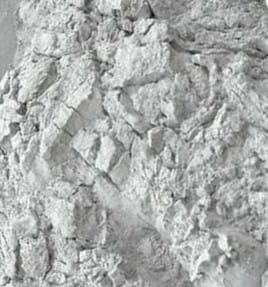
Fig 1: Cement
2) Fine Aggregate
Sand free from all inorganic impurities extracted from the Narayani River that complies with the specification of IS383:2016 (Specification for Coarse and Fine Aggregate) passing through a 4.75 mm sieve was used.

Fig 2: Fine Aggregate
3) Coarse Aggregate
Crushed stone as specified in IS383:2016 (Specification for Coarse and Fine Aggregate) passing from 20 mm and retained at 10 mm size sieve was used.
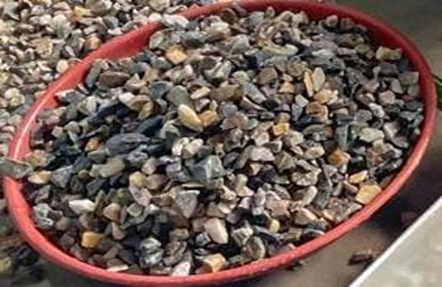
Fig 3: Coarse Aggregate
4) Water
Water plays a crucial role in the setting and hardening of concrete, and it approximately makes up 15-18% of the concrete mix. It was observed that the use of potable water for construction activity results in an increase in compressive strength and split tensile strength. Therefore, good quality water used for drinking purposes is used for the experiment.
5) Fly Ash
Burnt wood fly ash, a fine greyish to dark brown colour, was used as a partial replacement for cement.
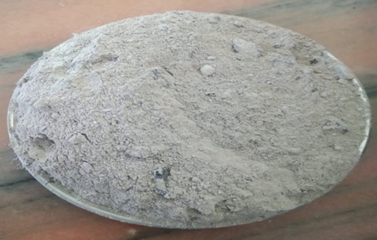
Fig 4: Fly Ash
6) Thermocol
Solid beads of Expanded Polystyrene passing through a 4.75 mm sieve were used as a partial replacement for fine aggregate.
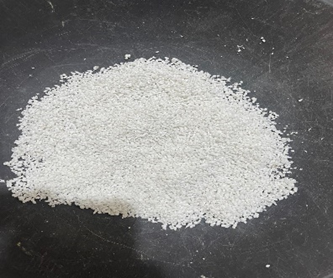
Fig 5: Thermocol
B. Mix Proportioning and Preparation
To reach the study's objectives, a well-planned and structured approach is followed. The research outlines a series of precise steps for using fly ash and thermocol as replacements for cement and fine aggregates.
First, materials like ordinary Portland cement (OPC), fly ash, thermocol beads, coarse aggregates, and fine sand are gathered from trusted sources, making sure they meet required quality standards. The collected fly ash and thermocol are checked and cleaned to get rid of any unwanted stuff or dirt. When preparing the mixture, fly ash was introduced as a partial cement replacement in the pattern of 30%, 40%, 50%, and 60% by weight, while thermocol beads were proposed as replacements for fine aggregates in the proportions of 0.2%, 0.4%, and 0.6% by weight. The materials are batched in a 1:2:4 ratio to prepare M15-grade concrete. The water-to-cement ratio was kept at 0.5. The materials were first dry-mixed for homogeneity so that the constituents were evenly distributed. Water was gradually added during the mixing process to prevent segregation and the development of lumps. Manual mixing was done following the steps as specified in IS 516:1959.
After mix preparation, it is poured into molds of standard dimensions for compressive strength and tensile strength tests. The cube molds are 150 mm × 150 mm × 150 mm, and the cylinder molds are 150 mm in diameter and 300 mm in height. To overcome air voids, molds have been layered and compacted with a cube vibrating table as per IS 1199:2018. The samples were allowed to cure for 24 hours before they were removed from the mold, and after removing them, they were placed in tanks filled with water. Curing was done for 7 and 28 days, respectively, in agreement with IS 516:1959 to optimize the strength properties required.
C. Testing Procedures
After the samples were cured for the required days, the following strength tests were performed on the concrete samples:
1) Compressive Strength Test
The hardness of the concrete was determined through the use of a compressive testing machine as specified in IS 516:1959, where compressive strength was determined using the formula:
Compressive Strength = Final Load/Cross-Sectional Area Compressive Strength
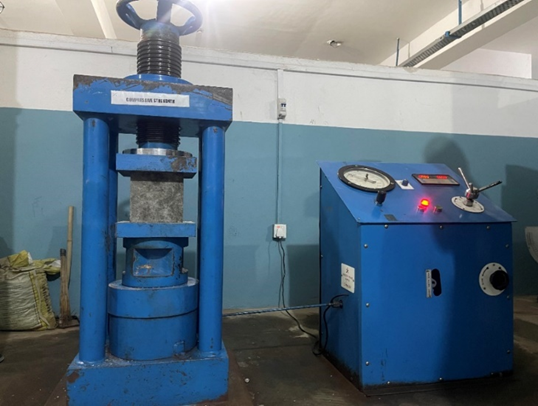
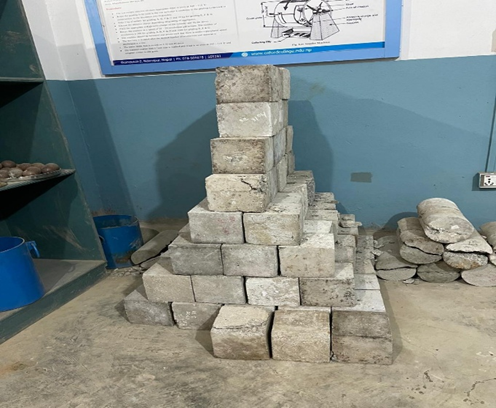
Fig 6: Compressive Strength Test
2) Split Tensile Strength Testing:
The split tensile strength test was performed as per the provisions in the standard IS 5816:1999 (Methods of Test for Splitting Tensile Strength of Concrete Cylinders). The tensile strength was calculated using:
Tensile Strength = 2 × Final Load / (π × Length of Cylinder × Diameter of Cylinder)
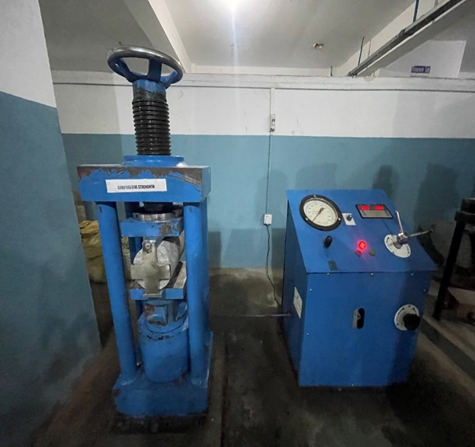
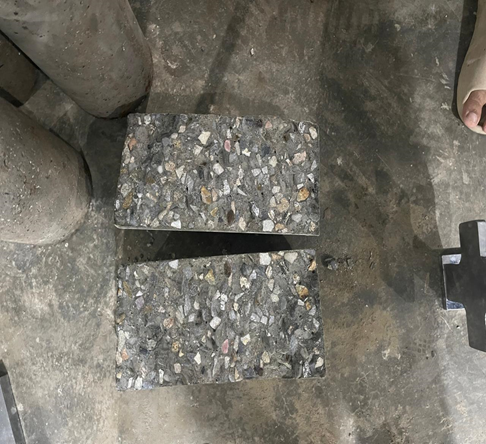
Fig 7: Split Tensile Strength Test
III. RESULT AND DISCUSSION
A. Comparison of Density
Density is an important parameter that indicates the strength of concrete. Concrete with higher density provides greater strength, whereas lower-density concrete provides lesser strength. The density of concrete mainly depends upon the properties and mix proportions of the ingredients used in it. Figures 8 and 9 represent the relation between the density vs. percentage of thermocol and fly ash in 7-day and 24-day cured samples. The thermocol is added in the proportions of 0.2%, 0.4%, 0.6%, and fly ash at 30%, 40%, 50%, and 60% by weight. From the graph, it is seen that the density is gradually decreasing with an increase in the percentage of fly ash and thermocol in concrete.
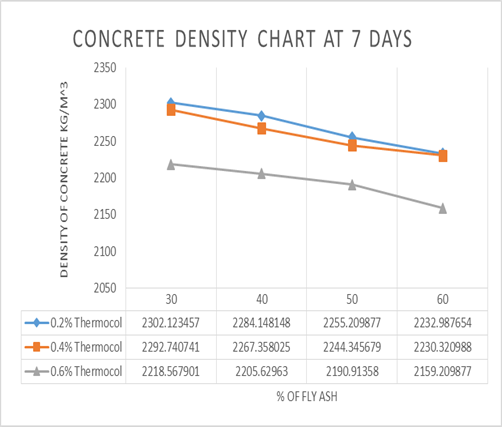
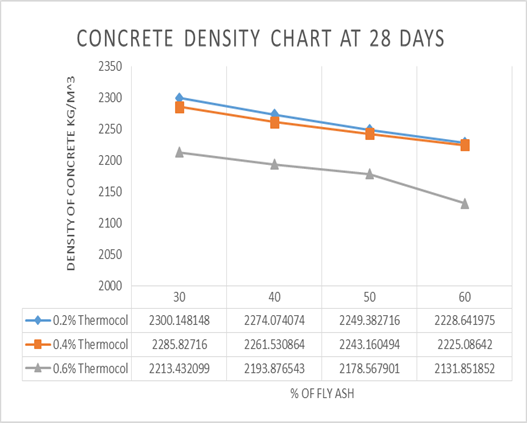
Figure 8: Density vs % of fly ash on 7 days Figure 9: Density vs % of fly ash on 28 days
B. Compressive Strength Comparison at 30% fly ash and (0.2%, 0.4% & 0.6%) thermocol
Figure 10 shows the compressive strength of concrete with 30% fly ash replacement at varying thermocol percentages (0.2%, 0.4%, and 0.6%) for 7 and 28 days of curing. For M15 concrete, the target strength of 9.75 N/mm² is needed to be achieved after 7 days and 15 N/mm² after 24 days of curing. The addition of 0.2% thermocol results in the highest compressive strength of 11.556 N/mm² at 7 days and 16.149 N/mm² at 28 days. At 0.4% thermocol, the 7-day strength decreases to 10.519 N/mm², whereas the 28-day strength lowers to 16 N/mm². However, at 0.6% Thermocol, the strength further decreases to 10 N/mm² at 7 days and 15.112 N/mm² at 28 days. The results here indicate that the compressive strength for both 7-day and 28-day curing initially improves with small Thermocol additions but diminishes as the Thermocol amount gets increased. Also, the 28-day curing consistently yields higher strength than the 7-day curing across all percentages as the concrete gets more time for hydration.

Figure 10: Comparison of Compressive Strength at 30% fly ash and (0.2%, 0.4% & 0.6%) thermocol on 7 days and 28 days
C. Compressive Strength Comparison in 40% fly ash and (0.2%, 0.4% & 0.6%) thermocol
Figure 11 demonstrates the compressive strength of concrete with 40% fly ash replacement at varying percentages of thermocol (0.2%, 0.4%, and 0.6%) for 7 and 28 days of curing. For the normal M15 concrete, the targeted compressive strength should be 9.75 N/mm² at 7 days, with a 28-day strength of 15 N/mm². At 0.2% thermocol, the compressive strength is highest, reaching 11.852 N/mm² at 7 days and 16.297 N/mm² at 28 days. For 0.4% thermocol, the 7-day strength slightly decreases to 11.704 N/mm², with a 28-day strength of 16.18 N/mm². At 0.6% Thermocol, the strength significantly reduces to 8 N/mm² at 7 days and 8.593 N/mm² at 28 days. These results indicate that small thermocol additions (0.2% and 0.4%) enhance compressive strength, whereas the increase in thermocol quantity leads to a significant strength reduction.
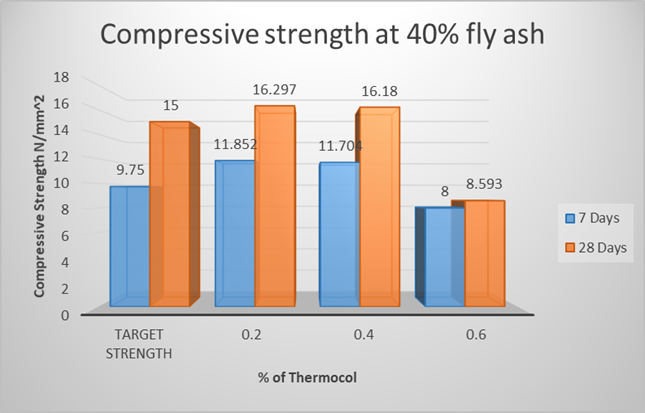
Figure 11: Comparison of Compressive Strength at 40% fly ash and (0.2%, 0.4% & 0.6%) thermocol on 7 days and 28 days
D. Compressive Strength Comparison in 50% fly ash and (0.2%, 0.4% and 0.6%) thermocol
Figure 12 shows the comparison of the compressive strength of concrete containing 50% fly ash at different percentages of thermocol. We can see that at 0.2% thermocol, the 7-day strength increases to 10.963 N/mm², and the 28-day strength drops to 14.963 N/mm². Further increasing thermocol to 0.4% results in a significant decrease of a 7-day strength to 6.741 N/mm² and a 28-day strength to 6.519 N/mm². Finally, at 0.6% thermocol, the 7-day strength reaches 3.778 N/mm², and the 28-day strength is 5.334 N/mm².
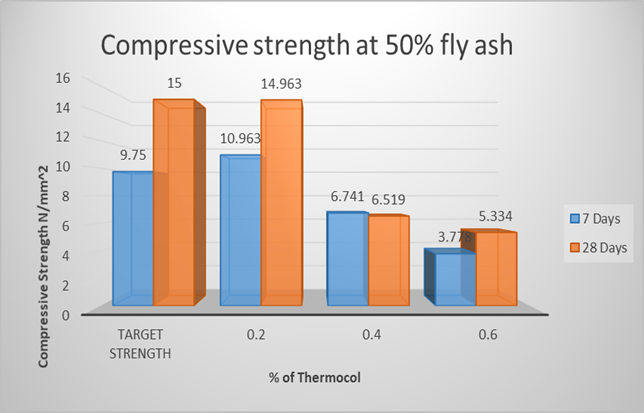
Figure 12: Comparison of Compressive Strength at 50% fly ash and (0.2%, 0.4% & 0.6%) thermocol on 7 days and 28 days
E. Compressive Strength Comparison in 60% fly ash and (0.2%, 0.4% & 0.6%) thermocol
Figure 13 shows the effect of varying thermocol percentages on the compressive strength of concrete containing 60% fly ash. A reduction in strength is observed as thermocol content increases. At 0.2% thermocol, the compressive strength measures 4.815 N/mm² at 7 days and 5.186 N/mm² at 28 days. When the thermocol percentage rises to 0.4%, the 7-day strength decreases to 4.593 N/mm², while the 28-day strength improves slightly to 5.63 N/mm². However, at 0.6% thermocol, both 7-day and 28-day strengths decline sharply to 2.223 N/mm² and 2.371 N/mm², respectively.
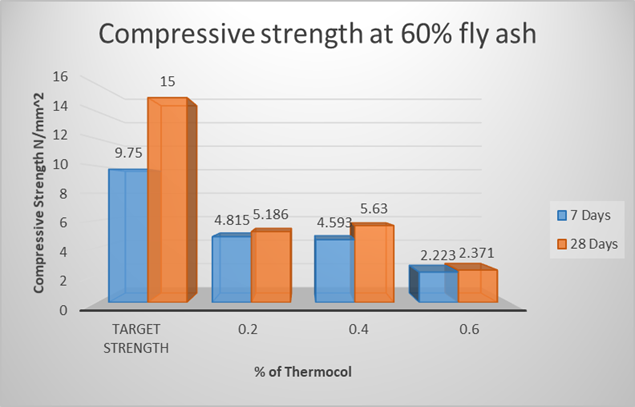
Figure 13: Comparison of Compressive Strength at 60% Fly Ash and (0.2%, 0.4%, & 0.6%) Thermocol on 7 Days and 28 Days
F. Compressive strength vs % of Thermocol and fly-ash at 7 days and 28 days
Figures 14 and 15 illustrate the relationship between compressive strength and varying percentages of fly ash (30%, 40%, 50%, and 60%) combined with the proportion of thermocol (0.2%, 0.4%, and 0.6%) in the concrete mix at 7 and 28 days. The results indicate that, for both curing periods, the concrete is generally stronger when there is less thermocol in the mixture. The strongest concrete was achieved with 0.2% thermocol, regardless of the amount of fly ash. As the amount of thermocol increases, the compressive strength decreases. Additionally, concrete gets stronger after 28 days than it does after 7 days, indicating an increase in strength with time. This highlights the value of making concrete lighter by incorporating thermocol while maintaining its strength.
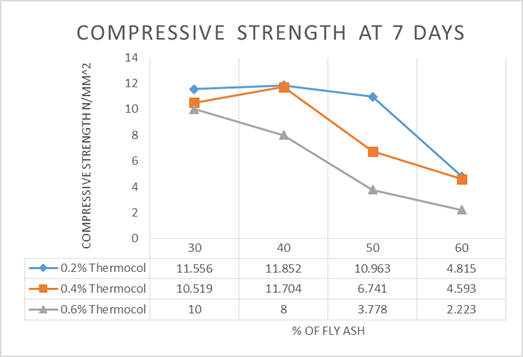
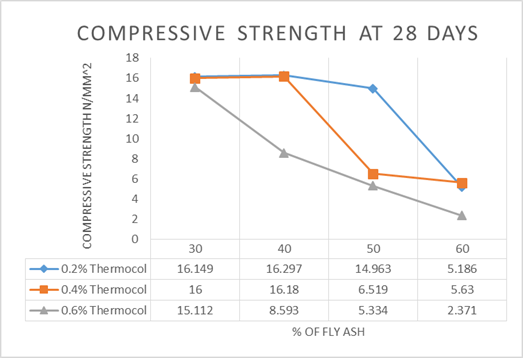
Figure 14: Compressive strength vs. % of thermocol and fly ash at 7 days Figure 15: Compressive strength vs. % of Thermocol and fly ash at 28 days
G. Split Tensile Test of 30% Fly Ash
Figure 16 shows the results of a test measuring the split tensile strength of concrete samples. These samples had 30% of their cement replaced with fly ash and different amounts of fine aggregate replaced with thermocol (0.2%, 0.4%, and 0.6%). The tensile strength decreases with an increase in the amount of thermocol. The strongest sample had 0.2% thermocol, measuring 1.70 N/mm², and the weakest had 0.6% thermocol, measuring 1.49 N/mm². This pattern indicates that an increase in thermocol decreases the concrete split tensile strength.
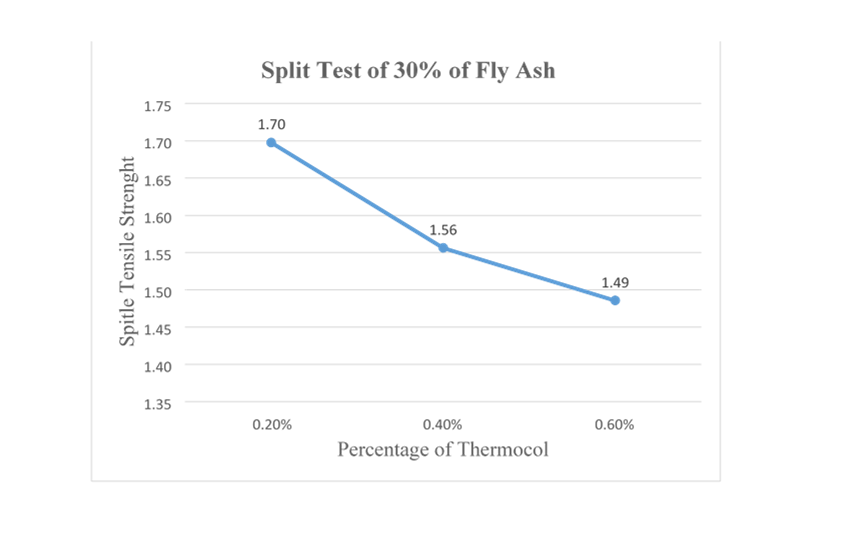
Figure 16: Split Test of 30% Fly ash
H. Split Test of 40% Fly ash
Figure 17 shows the results of a test measuring the split tensile strength of concrete samples. These samples had 30% of their cement replaced with fly ash and different amounts of fine aggregate replaced with thermocol (0.2%, 0.4%, and 0.6%). The tensile strength decreases with an increase in the amount of thermocol. The strongest sample had 0.2% thermocol, measuring 1.77 N/mm², and the weakest had 0.6% thermocol, measuring 1.20 N/mm². This pattern indicates that an increase in thermocol decreases the concrete split tensile strength.
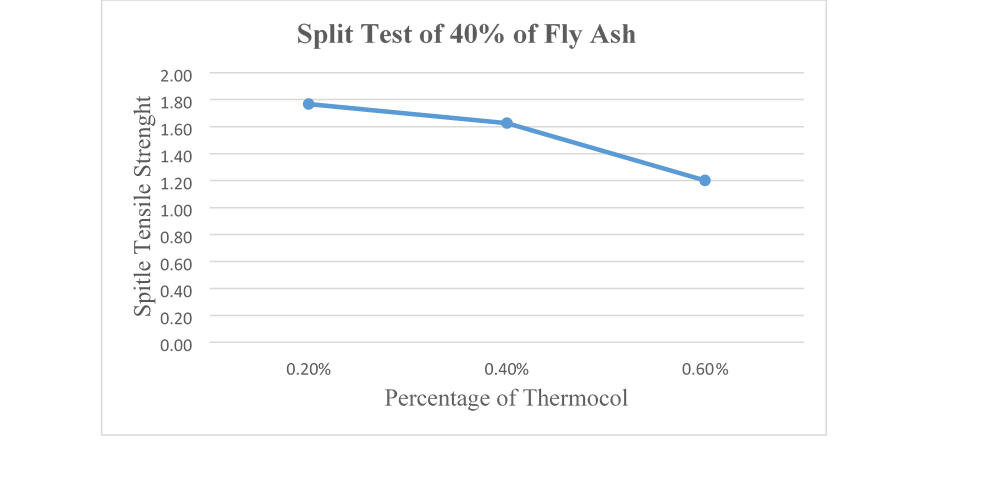 Figure 17: Split Test of 40% Fly ash
Figure 17: Split Test of 40% Fly ash
I. Split Test of 50% Fly ash
Figure 18 shows the results of a test measuring the split tensile strength of concrete samples. These samples had 30% of their cement replaced with fly ash and different amounts of fine aggregate replaced with thermocol (0.2%, 0.4%, and 0.6%). The tensile strength decreases with an increase in the amount of thermocol. The strongest sample had 0.2% thermocol, measuring 1.85 N/mm², and the weakest had 0.6% thermocol measuring 0.35 N/mm². This pattern indicates that an increase in thermocol decreases the concrete split tensile strength.

Figure 18: Split Test of 50% fly ash
J. Split Test of 60% Fly ash
Figure 19 shows the results of a test measuring the split tensile strength of concrete samples. These samples had 30% of their cement replaced with fly ash and different amounts of fine aggregate replaced with thermocol (0.2%, 0.4%, and 0.6%). The tensile strength decreases with an increase in the amount of thermocol. The strongest sample had 0.2% thermocol, measuring 0.71 N/mm², and the weakest had 0.6% thermocol measuring 0.28 N/mm². This pattern indicates that an increase in thermocol decreases the concrete split tensile strength.
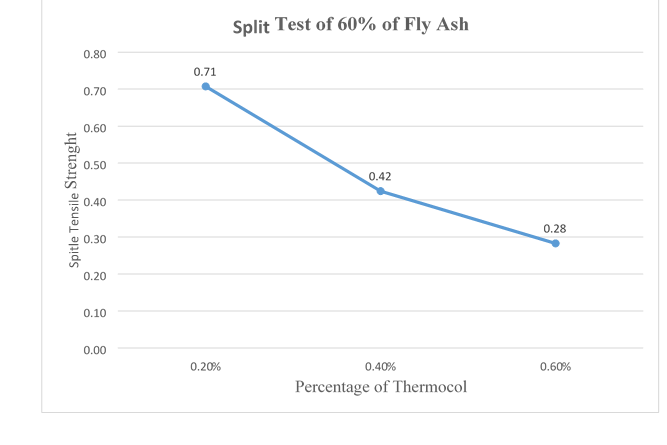
Figure 19: Split Test of 60% Fly ash
K. Split Tensile Strength
Figure 20 presents the split tensile strength results over two time periods of 7 days and 28 days for concrete samples with different percentages of fly ash and thermocol. The graph demonstrates that the split tensile strength is highest at 0.2% thermocol across all fly ash levels and decreases as the thermocol content increases to 0.6%. The tensile strength values are usually higher after 28 days than after 7 days, indicating that concrete naturally gets stronger over time. But the general pattern stays the same: adding more thermocol makes the concrete weaker, especially when combined with higher amounts of fly ash.
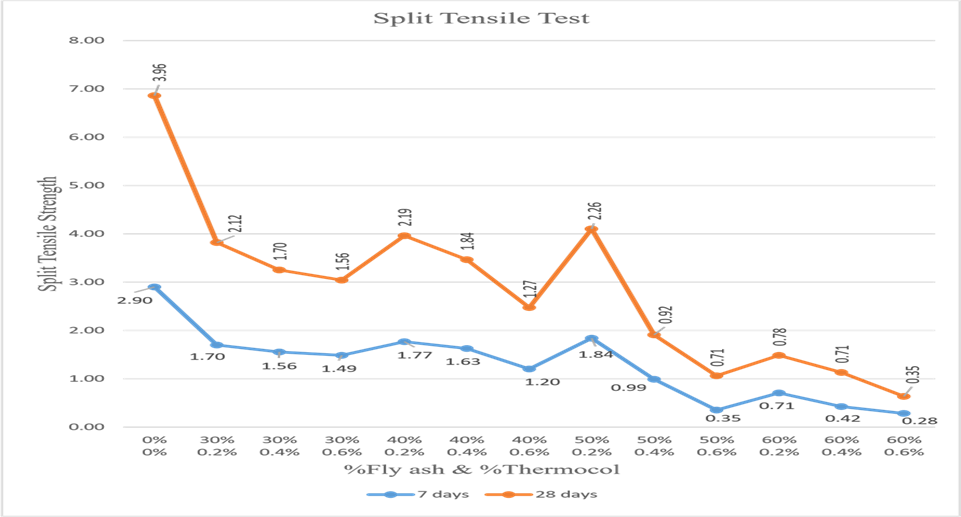
Figure 20: Split Tensile Strength in Graph
Conclusion
The purpose of this study was to determine the effect on the load-bearing capacity of concrete when the quantity of thermocol (expanded polystyrene) and fly ash is used as a partial replacement of cement and fine aggregate. A specialized approach was used by looking more into experimental methods and their corresponding effects, ensuring that all findings are relevant to the basic aim of the research. The conclusions, which were obtained from a series of experimental tests and analyses, offer a practical understanding of the properties of lightweight concrete incorporating these materials. Key findings from this study include the following: It was noticed that the density of concrete kept decreasing steadily as the amount of thermocol and fly ash increased. This trend showcases these materials\' potential to produce lighter concrete, which is beneficial in applications where reduced weight is a priority.
References
[1] Bureau of Indian Standards. (1959). Methods of test for strength of concrete (IS 516). New Delhi: Bureau of Indian Standards. Retrieved Form https://law.resource.org/pub/in/bis/S03/is.516.1959.pdf [2] Bureau of Indian Standards. (1970). Indian standard specification for coarse and fine aggregates from natural sources for concrete (Second Revision) (IS 383). New Delhi: Bureau of Indian Standards. Retrieved Form https://law.resource.org/pub/in/bis/S03/is.383.1970.pdf [3] Bureau of Indian Standards. (1982). Recommended guidelines for concrete mix design (IS 10262:1982). New Delhi: Bureau of Indian Standards. Retrieved Form https://law.resource.org/pub/in/bis/S03/is.10262.2009.pdf [4] Bureau of Indian Standards. (1996). Indian standard specification for physical test for hydraulic cement - Determination of compressive strength (IS 4031 [PTI]). New Delhi: Bureau of Indian Standards. Retrieved Form https://law.resource.org/pub/in/bis/S03/is.4031.1.1996.pdf [5] Bureau of Indian Standards. (2009). Recommended guidelines for concrete mix design (IS 10262). New Delhi: Bureau of Indian Standards. Retrieved Form https://law.resource.org/pub/in/bis/S03/is.10262.2009.pdf [6] Glas, D. J., Yu, Q., Spiesz, P. R., & Brouwers, H. (2015). Structural lightweight aggregates concrete. International Journal, 19, 16-18. Retrieved Form https://pure.tue.nl/ws/portalfiles/portal/3849194/1454149677895.pdf [7] Malak, K. R. (2015). Use of waste plastic in concrete mixture as aggregate replacement. International Journal of Engineering Education and Technology, 3(2), 28-34. Retrieved Form https://www.scirp.org/reference/referencespapers?referenceid=2517586 [8] Minspu, L. K., Ratnam, M. K. M. V., & Rangaraju, U. (2014). Experimental study on lightweight concrete with pumice stone, silica, and fly ash as a partial replacement of coarse aggregate. International Journal of Innovation Research in Science, 3(12), 18130-18137. Retrieved Form https:// www.ijset.in/wp -content/uploads/IJSET_V9_issue2_204.pdf [9] Mullik, A. K. (2007). Performance of concrete with binary and ternary cement blends. Indian Concrete Journal. Retrieved Form https://www.researchgate.net/publication/286873109_Performance_of_concrte_with_binary_and_ternary_cement_blends [10] Parmar, A., Joshi, C., Patel, U., & Vaghasiya, A. (2015). Lightweight concrete using EPS beads and aluminum powder. In Asian International Conference on Science, Engineering, and Technology (pp. 785-788). Retrieved Form https://www.researchgate.net/publication/277005404_Light_Weight_ConcreteUsing_EPS_Beads_and_Aluminium_Powder [11] Ramesan, A., Babu, S. S., & Lal, A. (2015). Performance of lightweight concrete with plastic aggregate. International Journal of Engineering Research and Applications, 5(8), 105-110. Retrieved Form https://www.ijera.com/papers/Vol5_issue8/Part%20-%205/N5805105110.pdf [12] Rao, S., Ratna Kumari, Y., Desai, V. B., & Swami, B. L. P. (n.d.). Fiber-reinforced lightweight aggregate (natural pumice stone) concrete. International Journal of Scientific & Engineering Research. Retrieved Form https://www.ijirset.com/upload/2014/december/51_Experimental.pdf [13] Shetty, M.S. (1982). Concrete technology: Theory and practice. New Delhi: S.Chand Publications. Retrieved Form https://www.researchgate.net/publication/284136726_Mix_Design_of_Light-Weight_Self-Compacting_Concrete [14] Vakhshouri, B., & Shmi Nejadi, S. (2016). Mix design of lightweight self-compacting concrete. University of Technology Sydney, 4(1), 1-14. Retrieved Form https://www.researchgate.net/publication/284136726_Mix_Design_of_LightWeight_Self-Compacting_Concrete [15] Sapkota, S.C., Yadav, A., Khatri, A. et al. Explainable hybridizedensemble machine learning for the prognosis of the compressive strength of recycled plastic-based sustainable concrete with experimental validation. Multiscale and Multidiscip. Model. Exp. and Des. 7, 6073–6096 (2024). https://doi.org/10.1007/s41939-024-00567-4 [16] Chhetri Sapkota, Sanjog and Dahal, Dipak and Yadav, Ajay and Dhakal, Dipak and Sharma, Ram Kumar and Saini, Gaurav, A Paradigm Shift in Corrosion Inhibition using Botanical Extracts: From Conventional Methods to Advanced Methods for Reinforcing Steel, https://ssrn.com/abstract=4963462 or http://dx.doi.org/10.2139/ssrn.4963462 [17] Ajay Yadav; Dipak Dahal; Sanjog Chhetri Sapkota; Pawan Dumre; Binay Kumar Sah. “Experimental Study on the Mechanical Properties of SustainableConcrete using Recycled Plastic and Glass Waste.” Volume. 9 Issue.11, November-2024 International Journal of Innovative Science and Research Technology (IJISRT), 93-101, https://doi.org/10.38124/ijisrt/IJISRT24NOV406 [18] Milan Kandel; Sandhya Ghimire; Nikita Bhatta; Bijaya Poudel; Isha Adhikari; Aarti Acharya; Ajay Yadav. “An Experimental Study on Concrete Strength Optimization with Surkhi as an Eco-Friendly Sand Substitute.” Volume. 9 Issue.11, November-2024 International Journal of Innovative Science and Research Technology (IJISRT), 172-184, https://doi.org/10.38124/ijisrt/IJISRT24NOV566 [19] Muktta Narayan Shrestha, Jamuna Kandel, Pawan KC, Swastika Poudyal, Ajay Yadav, Ashish Poudel.\"Performance Evaluation of Plastic Waste as Partial Replacement of Fine Aggregate in Concrete\", Volume 12, Issue XI, International Journal for Research in Applied Science and Engineering Technology (IJRASET) Page No: 1181-1187, ISSN : 2321-9653, www.ijraset.com
Copyright
Copyright © 2024 Sandip Sharma, Santosh Bhandari, Bibek Poudel, Sumit Poudel, Sishir Kunwar, Prabin Dhakal, John Poudel, Ajay Yadav. This is an open access article distributed under the Creative Commons Attribution License, which permits unrestricted use, distribution, and reproduction in any medium, provided the original work is properly cited.

Download Paper
Paper Id : IJRASET65502
Publish Date : 2024-11-24
ISSN : 2321-9653
Publisher Name : IJRASET
DOI Link : Click Here
 Submit Paper Online
Submit Paper Online

